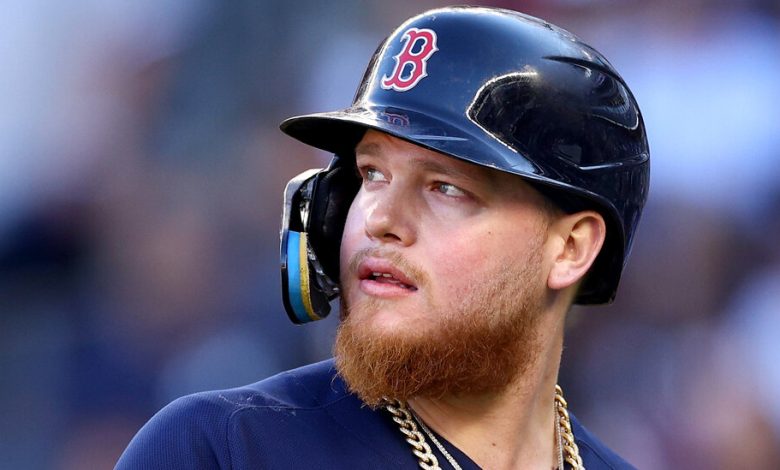Shave and a Haircut? No Thanks.

When the New York Yankees introduced Juan Soto to the news media last week after a blockbuster trade with San Diego, their new slugger was already in midseason form.
His cheeks were smooth and his hair was short. Not even a curl poked out from beneath his brand-new Yankees cap.
That’s not always a given for the club’s acquisitions, many of whom arrive with some assembly required. Such is the case for Alex Verdugo, a bearded outfielder acquired in a Dec. 5 trade with Boston. Verdugo, a slick-fielding 27-year-old, faces a choice that is unique to the Yankees: Adhere to the team’s ban on beards and long hair, instituted by team owner George Steinbrenner in 1976, or hit the bench.
For the Yankees, who still don’t have names on the backs of their jerseys, adhering to an appearance policy created by an owner who died in 2010 is yet another tradition that makes them stand out from other teams. But in an era when facial hair is common even in the corporate world, a sports team with strict rules for grooming inspired one former Yankee to wonder aloud what it might be costing the team in terms of signing new players.
“This might be an unpopular take to Yankees fans, but you’d be surprised how much more attractive the Yankees would be if they got rid of that facial hair rule,” Cameron Maybin, a former Yankee, wrote on X this month. “You wouldn’t believe how many quality players just think it’s a wack rule to have.”



Johnny Damon was known for his long hair and beard in his time with the Red Sox, but he went clean-cut for the Yankees in 2006. He has brought back the beard and hair in retirement.Credit…Photos by Winslow Townson/Associated Press; Mark Mandrake/New York Yankees, via Reuters; Johnny Damon
To be clear, plenty of prominent players over the years have been willing to cut their hair or shave their face — provided the paycheck was large enough.
The policy, which allows only for a neat mustache, did not scare away bearded free agents like Gerrit Cole ($324 million in 2019), Carlos Rodón ($162 million in 2023) or Johnny Damon ($52 million in 2005). Nor did it get in the way of a 2005 trade that sent the future Hall of Famer Randy Johnson from Arizona to New York. Mr. Johnson, who was rarely known for compromise, agreed to waive his no-trade clause — and cut his long, shaggy mullet — in exchange for a two-year, $57 million contract extension.
Even Don Mattingly, the former Yankees captain who once publicly butted heads with the team over the policy — and had his haircut mocked on “The Simpsons” — said players will generally find a way to make things work.
“Seems like that shouldn’t be a game-changer if that’s where you want to play, right?” said Mr. Mattingly, whose long hair got him benched for a game in 1991. At the time, he lashed out at the rule, volunteering to give up his captaincy and questioning “whether I belong in this organization anymore.”
The decades since have softened his views.
“Looking back, it wasn’t really about the hair — it was more the way they went about it,” said Mr. Mattingly, who is currently the bench coach of the Toronto Blue Jays. “Nobody said anything to me about getting it cut before that. Then that day it was either get it cut or you don’t play. That rubbed me the wrong way. I would have always gotten it cut if they said: It’s a little long. Can you get it cut?”
 Credit…Focus on Sport/Getty Images
Credit…Focus on Sport/Getty Images‘Looking back, it wasn’t really about the hair — it was more the way they went about it.’
Don Mattingly, on his reaction to the Yankees benching him over his haircut in 1991.
With a majority of players hoping to secure as much money as possible in free agency, publicly saying they would not consider the Yankees would be bad for business. But according to Aneudys Duran, a personal barber to several major leaguers, the restrictions are a consideration for players before they join the team.
“The policy has been in place for so long that nobody really talks about it unless a player is traded,” said Mr. Duran, who is known around the game as Andy Fade. “Then it’s like, ‘Damn, I have to shave and change my look.’”
Mr. Duran — who has groomed some of the game’s biggest stars, including Aaron Judge, Mike Trout and Max Scherzer — said he had heard some players say the policy would make them want to sign elsewhere. He respects the policy to a point, he said, and wouldn’t advocate long hair or an untamed beard, but he believes the team could be less rigid.
“If it stays clean, just loosen up a little bit and let the kids be who they are,” he said.
Those who have been subjected to the Yankee clippers say it’s just part of the price for playing for one of the game’s premier organizations.
“I’m not surprised the policy is still in place because I always feel if you want to be a Yankee, you need to abide by their rules,” said Mr. Damon, who was known for his bushy beard and long hair in his time with the Red Sox. He added, “When the boss pays you top dollar over any other team, you have to listen to what your boss wants.”



Oscar Gamble was one of the first players affected by the Yankees’ appearance policy, with the team making him trim his Afro after trading for him before the 1976 season.Credit…Photos by Associated Press; The New York Times; Fairchild Archive, via Getty Images
Mr. Damon, who was known as a free spirit in most of his early stops, does have one regret of how he handled his transition to the team.
“The Yankees sent me to a great guy who just wanted to make it look proper,” he said. “I should have went straight Mohawk. But all this happened in, like, two days. I wish I had more time to think for myself.”
When Mr. Steinbrenner first instituted his policy, prominent players like Thurman Munson, Catfish Hunter, Oscar Gamble and Lou Piniella were all in violation of the rules. Mr. Gamble had a signature Afro that was “drastically shorn” and Mr. Piniella engaged in a war of words with Mr. Steinbrenner over having to cut his hair and shave.
In the years since, the team has had fairly little trouble enforcing the policy, but players have occasionally spoken out against it. Among the most prominent instances came in 2020, when Andrew McCutchen, a former Yankee, was openly critical of the rules.
Mr. McCutchen had cut off his long locs for charity in 2015, but he said that if he had still had them when he was traded to the Yankees in 2018, cutting them under duress would have been a “very tough thing for me to do.”
Matty Conrad, a men’s grooming expert for GQ, said he found a policy like the Yankees’ “fascinating” in today’s world.
“The idea of being able to control people’s expressions outside of the workplace is becoming very outdated,” Mr. Conrad said. He added that facial hair can be a cornerstone of personal expression: “It’s hard to side with people who want to squelch that with the idea that you can’t be a professional like that.”

Jordan Montgomery traded his clean-cut Yankees look for a full beard during his run to a World Series title with Texas.Credit…Christian Petersen/Getty Images
In perhaps the surest sign that the policy is not popular among Yankees players, many of them — including Jordan Montgomery, a former Yankee who just helped the Texas Rangers win the World Series — sprout beards the second they play somewhere else.
But like it or not, the policy has stood the test of time, even surviving the lampooning of Mr. Mattingly’s sideburns in a 1992 episode of “The Simpsons.”
“You know what’s cool about that? And nobody really talks about it,” Mr. Mattingly said. “That was recorded before it ever happened.”
Mr. Mattingly said the Yankees were in Anaheim, Calif., earlier in the 1991 season when he and Steve Sax recorded their lines for the show. The benching over his hair didn’t happen until August.
As usual, “The Simpsons” was inexplicably predicting the future. Much to the chagrin of some of today’s players, the Yankees remain firmly in the past.





